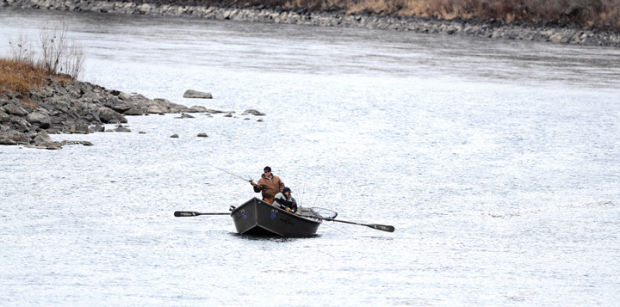forum
library
tutorial
contact

Steelhead Surprise on the Clearwater
by Eric BarkerLewiston Tribune, February 13, 2014
|
the film forum library tutorial contact |

|
Steelhead Surprise on the Clearwaterby Eric BarkerLewiston Tribune, February 13, 2014 |
 LEWISTON (AP) -- Steelhead anglers fishing the Clearwater River have seen restrictive regulations, low bag limits and a disappointing return of B-run fish this fall and winter.
LEWISTON (AP) -- Steelhead anglers fishing the Clearwater River have seen restrictive regulations, low bag limits and a disappointing return of B-run fish this fall and winter.
Those conditions have kept efforts low, but anglers willing to face them have experienced some darn good fishing at times.
"You basically have the river to yourself," said Andy Alldredge of Camp, Cabin and Home in Lewiston. "There is plenty of fish around."
The Clearwater, especially the stretch between Lewiston and Orofino, is not the best place to go for those looking to take home a steelhead. Special regulations, aimed at ensuring there are enough steelhead for spawning at hatcheries, restrict harvest to fish that are no more than 28 inches long. That has led to some funny-looking harvest statistics.
For example, last weekend anglers on the Lewiston-to-Orofino stretch of the Clearwater landed a steelhead for every six hours of fishing. That's about as good as it gets there. But anglers had to put in 56 hours for every keeper.
"The catching is very good, I would say it's as good as it is in good years. The harvest rates are way down because you can't harvest the big fish," said Joe DuPont, regional fisheries manager for the Idaho Department of Fish and Game at Lewiston. "The reason the catch rates are so good is the effort is very low and the big fish stay out there. We are not cropping (big) hatchery fish, and there is not a lot of competition."
Don Whitney, another Fish and Game biologist, said he and the creel clerks who work for him have heard few complaints from anglers about the harvest restrictions.
"It seems like people understand the restrictions, that if we don't have the brood, we can't release the smolt."
Hatchery fish are in the system so anglers can catch them. But the system depends on enough fish escaping the fisheries and returning to hatcheries so the next generation of fish can be produced.
Normally that is not a problem. In fact, fisheries managers often fret that too many hatchery fish remain left uncaught and that they could pose a threat to protected wild steelhead by breeding with them and reducing the fitness of their offspring.
But this was a poor year for steelhead returns and especially bad for B-run steelhead bound for the Clearwater. Last October, fisheries officials estimated only 5,800 hatchery B-run steelhead would return this fall and only about 2,000 would be bound for Dworshak National Fish Hatchery. The hatchery has a goal of collecting 2,000 steelhead for spawning.
Dworshak Hatchery met its goal of collecting about 500 steelhead in the fall and has started to collect the remainder of the fish. Both DuPont and Steve Rodgers, managers of the Dworshak complex, said they expect to meet collection goals.
"We really don't have any concern about making it," Rodgers said.
learn more on topics covered in the film
see the video
read the script
learn the songs
discussion forum
